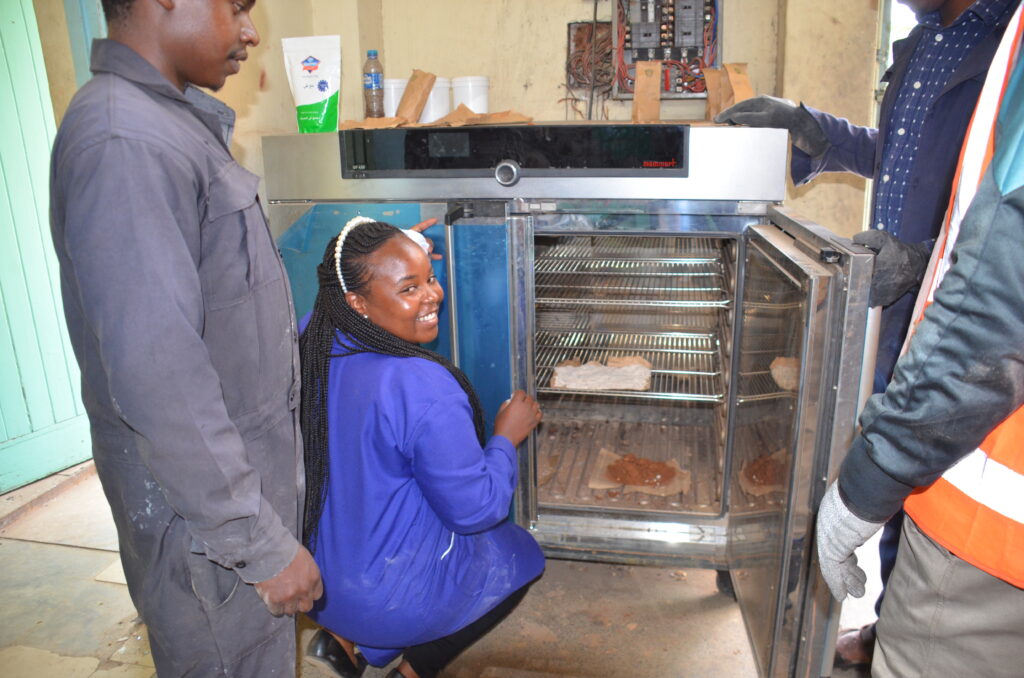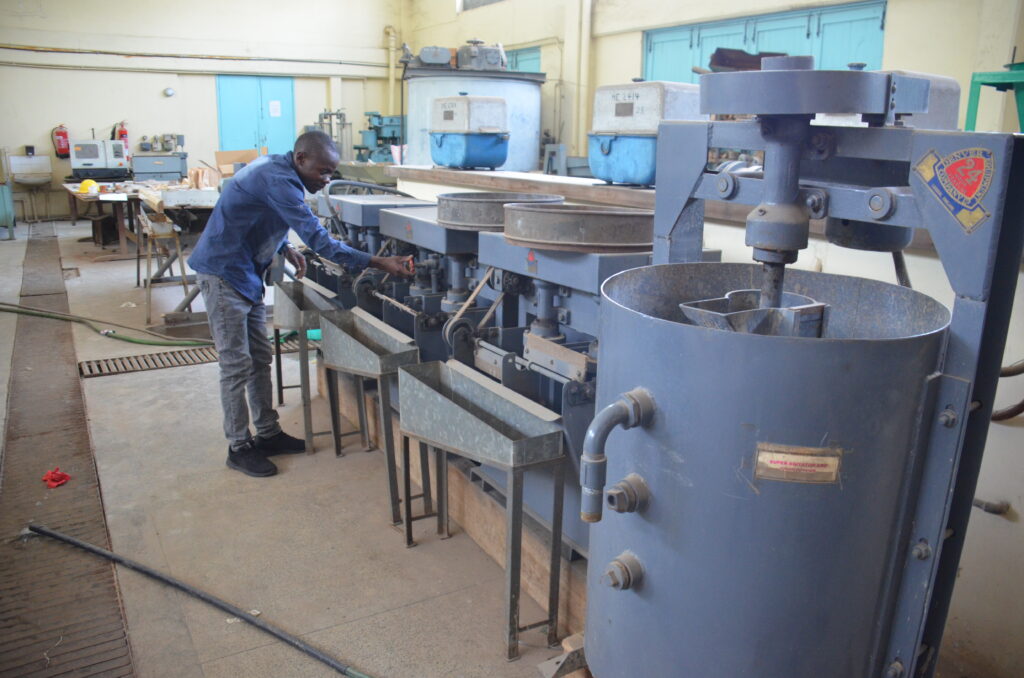Lab
Silence reigns inside the cavernous mineral laboratory at Madini House in Nairobi’s Industrial Area. Tiny specks of dust drift placidly through the cool air of this facility whose sprawling expansiveness and brooding silence evokes images of an ancient mechanical shrine.
Over the floor, assorted heavy-duty dust-coated equipment; rock cutters, crushers, giant ovens and a host of other mechanical tools are carefully stacked.
The shelves, heavy with rock specimens, line the high walls. Towering above everything is a massive steel gangplank, complete with a ladder and a walkway.
From somewhere, a sharp click of a mechanical lever being yanked breaks the tranquility. Moments later, the sporadic thump-thump of a rock crusher calibrated on low velocity follows. The machines are awakening.
A geologist carries a rock sample to a jagged steel spherical blade that is whirling at such phenomenal speed that it’s just a blur.
With practiced caution, he gently feeds one edge of the rock to the blade. At the instant of contact, the rock screams. The lethal steel shrieks back. Sparks fly. A furious storm of dust erupts. A few inches above the rotating blade, a tiny tap erupts and sends a thin jet of cold-water at the deadly blade to keep it from overheating.
Moments later, the deafening din subsides. The blade purrs softly, slows down and stops. The ensuing silence is equally as loud. Unbothered, the geologist holds up to the overhead light a wafer-thin slice of the rock. The fragment is so thin that it has a glass-like translucent quality.
“The thinness is critical for exact results under the petrographic microscope. You can see the distribution of elements on the sample,” he says.

Geologists drying a wet rock in a giant rock oven before the crushing process at the Madini Lapidary lab
The 90-year-old Madini Mineral Testing Laboratory holds a special place in Kenya’s mineral landscape as the only premier mineral processing, identification and classification center in the country.
First established in 1933 with help from the British Geological Survey, the laboratory has for decades remained a central cog in Kenya’s mining ecosystem. From being a significant enabler in mineral mapping, the laboratory has over time become a central theater for major mineral discoveries.
To mining experts, the lab is a venerable sanctuary where human expertise augmented by science and cutting-edge technology dissect rocks to lay bare the secrets within.
The Principal Secretary (PS) State Department for Mining Elijah Mwangi terms the Madini Laboratory as the bedrock of the country’s mining landscape. He adds that the facility not only offers vital information on mineral types in Kenya but also helps in acquisition of vital data on quality, distribution and location.
“This the only such lab in Kenya. It is solidly at the heart of mining and mineral processing. As a key enabler in mineral discoveries in the country, her analytical capacity aids in revealing the mineral resources we have,” says the PS.
Mining, by nature, is a highly specialized field that pays homage to proof of minerals before deployment of capital-intensive investments for exploitation. As a result, the lab is critical in providing geological insights on mineral distribution across Kenya.
Additionally, it aids in gathering vital geodata on Kenya’s mineral resources. The minerals analyzed include rare earths, construction, strategic minerals, precious and semi-precious stones.
The lab has both lapidary and chemistry sections. The lapidary lab is the arena for the heavy lifting in mineral processing.
This section is responsible for the physical operations including pulverizing of rocks into the desired powder quality. Here, rocks are also sliced into ultra-thin fragments for petrographic analysis. This entails deep examination of rock slices under the powerful microscope to study and map distribution of elements.
The chemistry section is markedly different from the lapidary. There are no massive crushers or giant ovens to dry wet rocks.
Equipped with ultra-modern computers and a wide range of sophisticated equipment like Specific Gravity Testers for testing actual weight in carats for precious stones like gemstones, X-Ray Fluorescence (XRFs) and X-Ray Diffraction (XRD) for defining chemical composition of any rock sample, this section remains the pinnacle of technological advancement in mineral engineering.
Already, the government has embarked on the process of transforming Madini into a regional mineral testing and processing center.
The journey towards ISO certification has started to grant the lab international standardization status and strategically place it as the main regional referral facility for mineral analysis in the region and beyond.
To fast-track the ISO certification process, Kenya has entered into partnership with the Indonesian Government on upgrading the lab into a world class facility.
In March, a delegation of Indonesian government officials and mineral experts met with a Kenyan delegation led by Cabinet Secretary for Mining, Blue Economy and Maritime Affairs Salim Mvurya over the creation of a joint technical team to draft a bilateral engagement framework over the project.
Currently, though Madini’s testing parameters are superior as per the regional standards, lack of internationally recognized standards has hampered the country’s mission to market herself as a mineral hub.
Kenya annually loses millions in revenue as miners eyeing the international market take their samples for testing in ISO certified laboratories in South Africa and Canada.
PS Mwangi says the collaboration between the two nations towards ISO certification of the lab will include equipment upgrade, capacity building for lab experts and joint partnerships in mineral exploration and analysis.
“This is the vision we have to make our lab into a world class mineral analysis center,” he says.
At the heart of this upgrading is Laboratory Information Management System (LIMS), a formidable online program to streamline lab operations and help track the mineral analysis process in real-time for miners. This will also eradicate fraudulent documentation for minerals.
Mr. Josiah Chumo, Head of the Lab, says Madini is poised to become the main referral facility for mineral analysis in the region.
“Getting the internationally recognized status is a special achievement that will market Kenya’s analytical capacity for minerals,” he notes.
Currently, the mining department is decentralizing laboratory services in strategic regions to promote the testing services for artisanal miners in counties. The regions mapped for mineral laboratories include Mombasa, Kakamega, Embu, Garissa, Lodwar and Kisumu. Others are Eldoret, Nakuru, Nyeri and Kitui.
